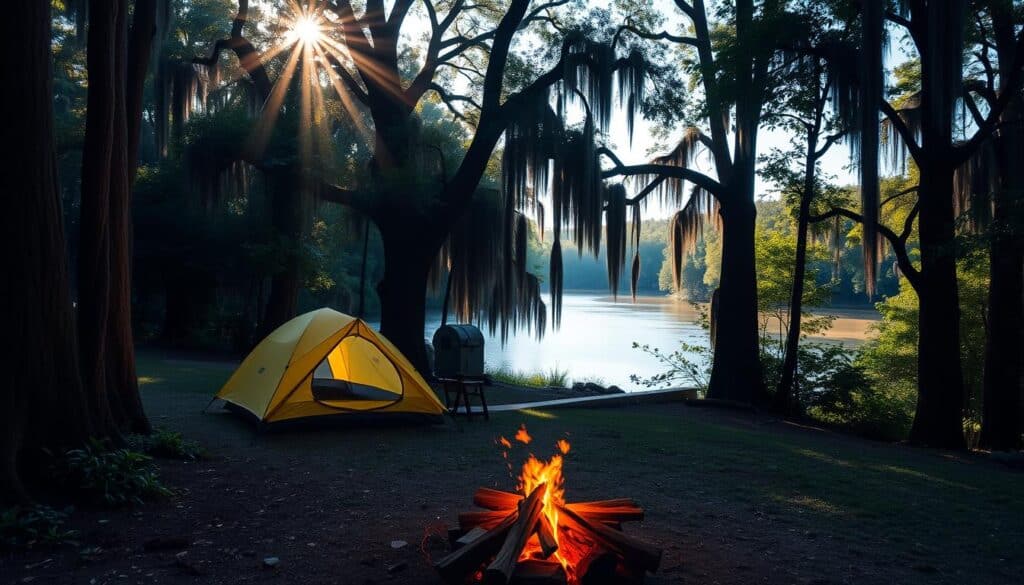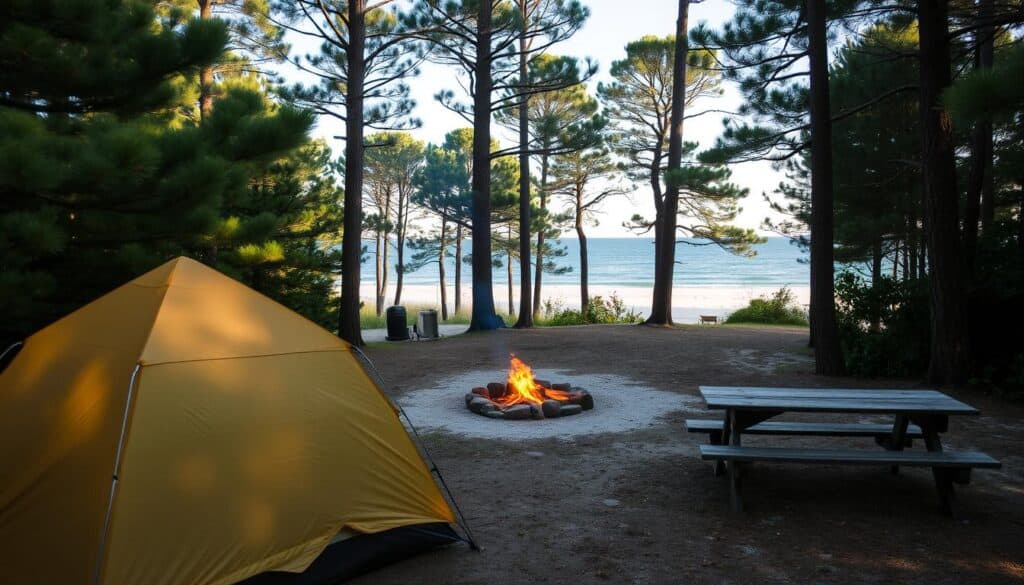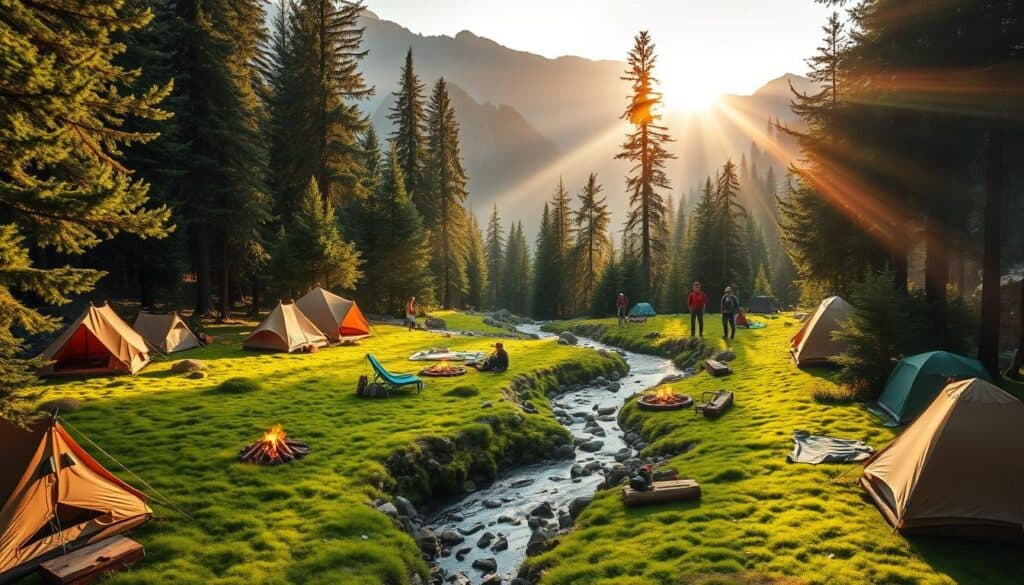Suwannee River State Park, part of the Florida State Parks system, is a haven for outdoor enthusiasts, offering a wide range of activities and stunning natural beauty. The park features over 15 miles of trails available for hiking, 30 tent or RV sites, and 5 furnished cabins for rental. With its diverse wildlife and well-maintained facilities, Suwannee River State Park is an ideal destination for those looking to connect with nature.
Located in Florida, Suwannee River State Park is surrounded by various towns that offer motels, convenience stores, and restaurants for visitors. The park is also home to the Suwannee River Wilderness Trail, which spans a total length of 207 miles, beginning in northern Florida and flowing to the Gulf of Mexico. With its rich history and natural attractions, Suwannee River State Park is a must-visit destination for outdoor enthusiasts.
Key Takeaways
- Suwannee River State Park offers over 15 miles of trails for hiking and biking
- The park features 30 tent or RV sites and 5 furnished cabins for rental
- The Suwannee River Wilderness Trail spans 207 miles, from northern Florida to the Gulf of Mexico
- Suwannee River State Park is part of the Florida State Parks system
- The park is home to diverse wildlife, including largemouth bass and Suwannee bass
- Various towns along the Suwannee River offer motels, convenience stores, and restaurants for visitors
Overview of Suwannee River State Park
Suwannee River State Park is a hidden gem located near the town of Ellaville, offering a unique blend of natural beauty, outdoor recreation, and historical significance. The park is situated in Suwannee County, Florida, and is easily accessible by car or boat, making it an ideal destination for those looking to experience the best of Suwannee River camping and Outdoor activities Suwannee River.
The park’s rich history dates back thousands of years, with evidence of human presence and activity in the area. Visitors can explore the park’s many trails, take in the scenic views, and enjoy a range of outdoor activities, including hiking, fishing, and kayaking. The park is also home to a variety of wildlife, including birds, fish, and other animals, making it a great spot for nature lovers and outdoor enthusiasts.
Some of the key features and activities available in the park include:
- Birding and wildlife viewing
- Boating and fishing
- Hiking and biking trails
- Cabins and camping facilities
- Picnicking areas and scenic overlooks
Whether you’re looking for a relaxing getaway or an action-packed adventure, Suwannee River State Park has something for everyone. With its stunning natural beauty, rich history, and wide range of outdoor activities, it’s the perfect destination for those looking to experience the best of Suwannee River camping and Outdoor activities Suwannee River.
| Activity | Description |
|---|---|
| Hiking | Explore the park’s many trails and take in the scenic views |
| Fishing | Try your luck in the Suwannee River and catch a variety of fish species |
| Kayaking | Paddle through the park’s waterways and enjoy the stunning natural beauty |
Natural Attractions
Suwannee River State Park is a haven for nature lovers and outdoor enthusiasts. The park’s diverse flora and fauna make it an ideal destination for bird watching and wildlife observation. With its scenic views and landscapes, the park offers a unique opportunity to connect with nature.
Scenic Views and Landscapes
The park’s natural beauty is characterized by its rolling hills, scenic overlooks, and winding trails. Visitors can enjoy the stunning views of the Suwannee River and surrounding landscape, making it a perfect spot for Bird watching Suwannee River. The park’s diverse landscape also supports a wide range of plant and animal species, including many species of birds, mammals, and reptiles.
Unique Flora and Fauna
The park is home to a variety of unique flora and fauna, including many species of trees, wildflowers, and wildlife. Visitors can explore the park’s trails and observe the Wildlife Suwannee River State Park in its natural habitat. The park’s diverse ecosystem supports a wide range of plant and animal species, making it a fascinating destination for nature lovers and outdoor enthusiasts.
Activities for Families
Suwannee River State Park offers a variety of family-friendly activities that cater to all ages, making it an ideal destination for a fun-filled family outing. The park’s picnic areas and playgrounds provide a safe and enjoyable space for kids to play, while the nature trails offer a fun and educational experience for the whole family.
Some of the hiking trails Suwannee River has to offer are suitable for kids and provide a great opportunity for families to explore the park’s natural beauty together. These trails are well-maintained and easy to navigate, making them perfect for families with children.
For families looking to spend quality time together, Suwannee River State Park is the perfect place to visit. With its range of family-friendly activities and hiking trails, the park has something for everyone. Whether you’re looking for a relaxing picnic or an exciting hike, Suwannee River State Park is a must-visit destination for families.
| Activity | Description |
|---|---|
| Picnic Areas | Safe and enjoyable space for kids to play |
| Playgrounds | Fun and educational experience for the whole family |
| Nature Trails | Suitable for kids and provide a great opportunity for families to explore the park’s natural beauty |
Hiking Trails for All Skill Levels
Suwannee River State Park offers a variety of hiking trails that cater to all skill levels, from easy walks to more challenging hikes. The park’s trails are perfect for outdoor activities Suwannee River, allowing visitors to explore the beautiful scenery and diverse wildlife. For those looking for a leisurely stroll, the beginner trails are an excellent choice, providing a gentle introduction to the park’s natural beauty.
For more experienced hikers, the intermediate trails offer a bit of a challenge, with longer distances and varying terrain. These trails are ideal for outdoor activities Suwannee River, such as hiking and birdwatching. The Florida National Scenic Trail within the park is a notable example, stretching 3.5 miles through multiple natural habitats. Visitors can enjoy the scenic views of the Suwannee River and surrounding landscape while exploring the hiking trails Suwannee River.

Some of the notable trails in the park include the Bridge to Bridge Trail, a 4.5-mile single-track trail classified as intermediate to challenging, and the administrative road in the White Springs tract, which provides a loop trail option totaling 5 miles. With its diverse range of hiking trails, Suwannee River State Park is an ideal destination for outdoor enthusiasts looking to explore the beauty of nature through hiking trails Suwannee River and other outdoor activities Suwannee River.
Water Activities on the Suwannee River
The Suwannee River offers a variety of water activities, including Suwannee River canoeing and kayaking, that allow visitors to explore the river and take in its natural beauty. With its calm waters and scenic views, the Suwannee River is an ideal destination for those looking to enjoy the outdoors.
For those interested in Suwannee River camping, there are several options available, including wilderness camps that can be used for free in specific sections along the river. These camps offer a unique opportunity to connect with nature and experience the beauty of the Suwannee River.
Some popular water activities on the Suwannee River include:
- Canoeing and kayaking: Rent a canoe or kayak and explore the river, taking in the stunning scenery and spotting wildlife along the way.
- Fishing: The Suwannee River is home to a variety of fish species, making it a popular destination for anglers.
Whether you’re interested in Suwannee River canoeing, kayaking, or fishing, the Suwannee River has something to offer. With its natural beauty and variety of water activities, it’s an ideal destination for outdoor enthusiasts.
Birdwatching in the Park
Suwannee River State Park is a haven for bird enthusiasts, offering a diverse range of species to spot throughout the year. The park’s unique location makes it an ideal spot for Bird watching Suwannee River, with numerous species of birds calling the park home.
According to birding experts, the best times for birdwatching in the park are during the spring and fall migrations, when the park is home to a variety of resident and migratory species. Some of the most popular bird species to spot include the bald eagle, osprey, and numerous species of waterfowl.
The Wildlife Suwannee River State Park is also home to a wide range of habitats, including forests, grasslands, and wetlands, which support a diverse range of bird life. Visitors can explore the park’s trails and waterways to spot a variety of bird species, from warblers and sparrows to hawks and eagles.
For those interested in birdwatching, the park offers a range of resources and activities, including guided bird walks and birding workshops. Whether you’re a seasoned birder or just starting out, Suwannee River State Park is a must-visit destination for anyone interested in Bird watching Suwannee River and experiencing the beauty of nature.
Wildlife Viewing Experiences
Visitors to Suwannee River State Park can enjoy a range of wildlife viewing experiences, with opportunities to spot common animals such as deer, turkey, and alligators. The park’s nature trails and scenic drives provide the perfect setting to catch a glimpse of the park’s resident wildlife.
For those looking to explore the great outdoors, Suwannee River State Park offers a variety of Outdoor activities Suwannee River, including hiking, biking, and kayaking. The park’s Wildlife Suwannee River State Park is home to a diverse range of wildlife, making it a must-visit destination for nature lovers and outdoor enthusiasts.
Common Animals in Suwannee River State Park
Some of the common animals found in Suwannee River State Park include:
- Deer
- Turkey
- Alligators
Tips for Safe Wildlife Observation
To ensure safe wildlife observation, visitors should keep a safe distance from the animals, avoid feeding them, and never approach or touch them. By following these simple tips, visitors can enjoy a fun and safe wildlife viewing experience in Suwannee River State Park.
Camping Options Available
For those looking to immerse themselves in the natural beauty of Suwannee River State Park, Suwannee River camping is an excellent option. The park offers a range of camping options, including campsites and cabins, to suit all needs and preferences.
The campsites are well-maintained and offer a range of amenities, including picnic tables, grills, and restrooms. Visitors can also rent cabins, which provide a more luxurious camping experience. Reservations can be made online or by phone, and it’s recommended to book in advance, especially during peak season.

Some of the amenities available at the campsites include:
* Picnic tables and grills
* Restrooms with showers
* Potable water
* Electrical hookups
* A concrete firepit
Suwannee River State Park is an ideal destination for outdoor enthusiasts, offering a range of activities, including hiking, biking, and kayaking. The park’s scenic views and diverse wildlife make it a perfect spot for nature lovers and photographers.
Photography Opportunities
Suwannee River State Park is a haven for photographers, offering a diverse range of subjects to capture, from stunning landscapes to abundant Wildlife Suwannee River State Park. The park’s unique blend of scenic views, diverse flora, and fauna makes it an ideal location for photography enthusiasts.
For those interested in Bird watching Suwannee River, the park is a paradise, with numerous species to spot and photograph. The best times for photography are during the early morning and late afternoon, when the light is soft and golden, making it perfect for capturing stunning images.
Some ideal spots for photography include the riverbanks, where you can capture stunning views of the Suwannee River, and the surrounding forests, which are home to a variety of wildlife. The park’s scenic trails also offer ample opportunities for photography, with numerous overlooks and observation decks providing breathtaking views of the surrounding landscape.
To make the most of your photography experience, be sure to bring a telephoto lens and be patient, as the park’s wildlife can be elusive. Additionally, consider visiting during the peak season for Bird watching Suwannee River, when the park is teeming with birdlife.
| Photography Tips | Description |
|---|---|
| Best Time | Early morning and late afternoon |
| Equipment | Telephoto lens and tripod |
| Subject | Wildlife Suwannee River State Park and Bird watching Suwannee River |
By following these tips and visiting Suwannee River State Park, you’ll be well on your way to capturing stunning photographs of the park’s unique landscapes and abundant wildlife.
Events and Programs
Suwannee River State Park offers a variety of events and programs throughout the year, catering to all ages and interests. From seasonal festivals to educational workshops, there’s something for everyone to enjoy. The park’s events and programs are designed to promote Family-friendly activities Suwannee River and Outdoor activities Suwannee River, making it an ideal destination for families and outdoor enthusiasts.
Some of the events and programs offered by the park include guided hikes, nature walks, and wildlife viewing tours. These activities provide a great opportunity to explore the park’s natural beauty and learn about its unique flora and fauna. Additionally, the park offers educational programs and workshops, such as outdoor skills workshops and nature photography classes, which are perfect for those looking to develop new skills or hobbies.

Whether you’re interested in Outdoor activities Suwannee River or simply want to spend time with your family, Suwannee River State Park has something to offer. With its wide range of events and programs, the park is an ideal destination for anyone looking to connect with nature and have a great time. So why not plan your visit today and experience all that the park has to offer?
Accessibility Features
Suwannee River State Park is committed to providing accessibility for all visitors, including those with disabilities. The park’s facilities, including restrooms and picnic areas, are wheelchair accessible.
The park also offers accessible trails and activities, such as paved paths and adaptive equipment for outdoor activities. Some of the accessible features and activities include:
- Wheelchair-accessible restrooms and picnic areas
- Paved paths and trails for easy navigation
- Adaptive equipment for outdoor activities, such as kayaking and fishing
As part of the Florida State Parks system, Suwannee River State Park is dedicated to ensuring that all visitors can enjoy the park’s natural beauty and recreational opportunities. By providing accessible facilities and activities, the park aims to create an inclusive and enjoyable experience for all visitors.
For more information on accessibility features and activities at Suwannee River State Park, visitors can contact the park directly or visit the Florida State Parks website.
| Accessible Feature | Description |
|---|---|
| Wheelchair-accessible restrooms | Located throughout the park |
| Paved paths and trails | Easy navigation for visitors with mobility impairments |
| Adaptive equipment | Available for outdoor activities, such as kayaking and fishing |
Nearby Attractions and Activities
When visiting Suwannee River State Park, there are plenty of nearby attractions and activities to explore. The park is surrounded by a range of natural wonders, making it the perfect base for Suwannee River canoeing and Suwannee River camping adventures.
Some popular nearby attractions include Fanning Springs State Park, located 30 minutes north of Suwannee, and Manatee Springs State Park, 7 miles downriver from Fanning Springs. These parks offer a range of activities, including short nature trails, swimming opportunities, and wooded, off-road bike trails.
For those looking to explore the Suwannee River, Gateway Marina provides houseboat rentals, while Bill’s Fish Camp and Motel is situated adjacent to a public boat ramp at Anderson’s Landing. The area is also known for its excellent fishing, with both freshwater and saltwater fishing opportunities available.

In addition to these attractions, the Suwannee River area is home to a range of other activities, including disc golf, geocaching, and golf cart rentals. The Spirit of the Suwannee Music Park, which spans 800 acres along the Suwannee River, offers a range of amenities, including a swimming pool, game room, and restaurant.
Whether you’re interested in Suwannee River canoeing, Suwannee River camping, or simply exploring the natural beauty of the area, there’s something for everyone in the Suwannee River area.
Tips for First-Time Visitors
When visiting Suwannee River State Park, it’s essential to be prepared and plan ahead. As one of the many Florida State Parks, Suwannee River State Park offers a unique experience. To make the most of your trip, bring plenty of water, sunscreen, and insect repellent, as well as comfortable clothing and shoes.
The park’s hours and entrance fees vary depending on the season, so it’s recommended to check the park’s website before visiting. With a little planning and preparation, visitors can enjoy the many activities and attractions that Suwannee River State Park has to offer, including hiking trails, water activities, and wildlife viewing.
Here are some additional tips for first-time visitors:
- Check the park’s website for up-to-date information on trail closures and park events
- Bring a map and compass or GPS device to navigate the trails
- Respect the park’s wildlife and natural resources
By following these tips and being prepared, visitors can have a safe and enjoyable experience at Suwannee River State Park, one of the many beautiful Florida State Parks.
| Trail Name | Length (miles) |
|---|---|
| Big Oak Trail | 12.5 |
| Suwannee River Trail | 0.7 |
| Earthworks Trail | 0.25 |
Safety Guidelines and Precautions
When engaging in outdoor activities Suwannee River, it’s essential to prioritize safety. Suwannee River State Park offers a unique and exciting experience, but visitors must be aware of their surroundings and take necessary precautions to ensure a safe and enjoyable trip.
To stay safe in nature, visitors should be mindful of the wildlife Suwannee River State Park is home to. This includes being aware of potential encounters with alligators, snakes, and other animals. By following simple guidelines, such as staying on designated trails and keeping a safe distance from wildlife, visitors can minimize their risk and enjoy the park’s natural beauty.
Some key safety tips to keep in mind include:
- Always hike with a partner and let someone know your itinerary
- Be aware of your surroundings and watch for potential hazards
- Keep a safe distance from wildlife and never feed or approach them
- Bring plenty of water and stay hydrated, especially during hot summer months
By following these simple safety guidelines and precautions, visitors can have a safe and enjoyable experience at Suwannee River State Park, enjoying the many outdoor activities Suwannee River has to offer while respecting the wildlife Suwannee River State Park is home to.
Local Dining and Accommodation Options
When visiting Suwannee River State Park, you’ll find a range of local dining and accommodation options to suit all tastes and budgets. From casual eateries to fine dining establishments, and from hotels to vacation rentals, there’s something for everyone. For family-friendly activities Suwannee River, consider staying at one of the many nearby hotels or resorts that offer amenities such as outdoor pools and complimentary breakfast.
Some popular accommodation options near Suwannee River State Park include:
- Quality Inn & Suites Live Oak I-10 Exit 283, with 63 air-conditioned rooms and an average user rating of 3.3/5
- Econo Lodge Live Oak, with 52 guestrooms and an average user rating of 3.7/5
- Quality Inn White Springs Suwanee, with 40 guestrooms and an average user rating of 3.5/5
These hotels offer a range of amenities, including free self-parking, outdoor pools, and complimentary breakfast. Prices start from around $83 per night, making them an affordable option for families and travelers. Whether you’re looking for a relaxing getaway or an action-packed adventure, Suwannee River State Park has something for everyone, with plenty of family-friendly activities Suwannee River to enjoy.
| Hotel | Number of Rooms | Average User Rating | Price per Night |
|---|---|---|---|
| Quality Inn & Suites Live Oak I-10 Exit 283 | 63 | 3.3/5 | $107 |
| Econo Lodge Live Oak | 52 | 3.7/5 | $88 |
| Quality Inn White Springs Suwanee | 40 | 3.5/5 | $83 |
Testimonials from Visitors
Visitors to Suwannee River State Park have shared their experiences and testimonials, highlighting their favorite activities and spots. Many have praised the park’s natural beauty and outdoor activities, such as hiking, camping, and wildlife watching.
Some visitors have noted that the park’s Outdoor activities Suwannee River are perfect for families and nature lovers. The park’s scenic views, unique flora and fauna, and opportunities for photography have made it a must-visit destination for many.
- Hiking and biking trails for all skill levels
- Opportunities for wildlife watching and photography
- Camping options, including RV and tent sites
According to visitor reviews, Suwannee River State Park is a great place to experience the best of Florida’s great outdoors. With its rich history, natural beauty, and outdoor activities, it’s no wonder that visitors return year after year.
As one visitor noted, “Suwannee River State Park is a hidden gem. The park’s natural beauty and outdoor activities make it a perfect destination for nature lovers and families.” With its unique blend of history, nature, and adventure, Suwannee River State Park is a must-visit destination for anyone looking to experience the best of Florida’s great outdoors.
Conclusion: Why Suwannee River State Park is a Must-Visit Destination
As you’ve discovered, Suwannee River State Park is a true gem in the heart of Florida, offering a wealth of outdoor adventures and natural wonders for visitors to explore. From the park’s stunning landscapes and diverse wildlife to the range of recreational activities available, there are countless reasons why this destination should be on every nature lover’s bucket list.
Recap of the Park’s Attractions and Activities
Whether you’re seeking scenic hiking trails, opportunities for birdwatching and wildlife viewing, or the chance to paddle the Suwannee River, this state park has something to captivate every interest. The park’s rich history, well-maintained facilities, and commitment to preserving the natural environment make it a truly special place to visit.
Final Thoughts and Recommendations
As you plan your trip to Suwannee River State Park, be sure to allow ample time to fully immerse yourself in the park’s natural beauty and diverse offerings. With over 1,800 acres of protected lands and a wide range of activities, you’ll find that a single day simply isn’t enough to experience all that this remarkable Florida State Park has to offer. So pack your hiking boots, grab your camera, and get ready to create lasting memories in one of Florida’s most treasured natural wonderlands.
FAQ
Where is Suwannee River State Park located?
Suwannee River State Park is located near the town of Ellaville in Florida.
What activities can visitors enjoy at Suwannee River State Park?
Visitors can enjoy a wide range of activities at Suwannee River State Park, including hiking, camping, canoeing, kayaking, fishing, birdwatching, and wildlife viewing.
What types of hiking trails are available in the park?
The park offers a network of hiking trails that cater to visitors of all skill levels, from easy walks to more challenging intermediate hikes.
Can visitors rent equipment for water activities on the Suwannee River?
Yes, visitors can rent canoes and kayaks to explore the Suwannee River within the park.
What are the best times to go birdwatching in Suwannee River State Park?
The best times for birdwatching are during the spring and fall migrations, when the park is home to a variety of resident and migratory bird species.
What types of wildlife can visitors expect to see in the park?
Visitors may spot a range of wildlife, including deer, turkey, and alligators, while exploring the park’s nature trails and scenic drives.
What camping options are available at Suwannee River State Park?
The park offers well-maintained campsites as well as cabins, providing a range of options to suit different needs and preferences.
Are there any accessibility features for visitors with disabilities?
Yes, the park has wheelchair-accessible facilities, including restrooms and picnic areas, as well as accessible trails and activities.
What should first-time visitors to Suwannee River State Park know?
First-time visitors should be prepared with necessary supplies, such as water, sunscreen, and insect repellent, and should check the park’s website for information on hours and entrance fees.
What safety precautions should visitors take while in the park?
Visitors should be aware of their surroundings, watch for wildlife, and avoid approaching or feeding animals. The park also provides first aid tips for outdoor activities.




















